We all know great customer service when we receive it. Providing exceptional customer service to others however, is the real challenge.
Providing good customer service is a vital habit that every customer rep should have. It’s the best way to increase customer loyalty and the most effective way of handling even the hardest of customers.
But, how can you and your customer service reps provide exceptional customer service consistently to every client? How does great customer service even look like?
What Is Exceptional Customer Service?
Exceptional customer service involves putting the customer first by giving them exactly what they need, all the time. It involves commitment and effort. However, exceptional customer service can get your company far.
It’s not just giving what the customer needs to solve their issue. Exceptional customer service is all about loyalty. It looks at clients as both simple users and potential brand ambassadors. The question is: “What would it take for this client to become an ambassador?” The answer involves what exceptional customer service looks like for that client.
Exceptional customer service isn’t just achieved by the customer service rep. It’s the result of a whole company working towards it.
For exceptional customer service to happen, the company needs to equip its customer service reps with the tools they need. These tools can range from coupons and discount codes to client policies and great work environments.
Exceptional customer service isn’t cheap or quick to implement. It involves a real investment from the company. However, giving exceptional service to its customers can dramatically increase customer loyalty and engagement, which can drastically affect both your product sales and your amount of clients in the long run.
What Does Truly Exceptional Customer Service Look Like?
Exceptional customer service is:
Empathetic
Customers want to be heard. The first step always involves the customer feeling like you’re on their side and understand their problem.
Remember, customer service is all about people. The better you understand them, the better you can support them.
So great customer service starts with empathy.
You need to listen to both what your customer is and isn’t telling you. Don’t just listen to the words. Listen to their tone of voice. If possible, look at their body language.
Ask yourself: Why is this problem an issue for them? What would their life be like if this situation was resolved? What’s the solution that’s best for them?
It isn’t always easy to answer this question. Sometimes, a customer asks for an impossible request or wants to pay less than they should. At this point, empathy is the most important factor.
Empathy allows you to find out your client’s issues and predict how they’ll react to different scenarios. That way, you can find ways to communicate that are best for them, find alternate solutions, and even give them answers that won’t be the ones your client is looking for.
Generous
As you know, acquiring a customer is more expensive than keeping an existing one. So instead of spending money on getting new customers, you should invest money in keeping the ones you have.
You can show generosity during customer service by both giving people refunds and coupons and being generous with your time.
A lot of companies have policies about how long a customer call or interaction should last. The logic behind these policies is that less time per customer equals less waiting time. But it doesn’t have to be like that.
Make sure you hire enough service reps to take care of all of your customers. By hiring enough people, they can spend as much time as they need with every client—without long waiting periods for everyone else.
Timely
To each customer, their problem is the biggest and most urgent. So you want them to feel that you are prioritizing them. After all, the more time they spend with their problem, the worse it gets.
Exceptional customer service involves solving your clients’ issues when they need you to. Your customer service reps shouldn’t make excuses if your business has missed deadlines or left the client without a service.
However, mistakes happen. So timely customer service involves planning ahead, in order to both avoid disappointing the customer and know what to do if that scenario happens.
Make sure your customer service is timely—not only by offering quick service, but also by preventing issues and providing effective problem-solving.
Surpassing expectations
Most people frequently receive poor customer support. So it’s great when you’re able to give something away or do something the client wouldn’t be expecting.
When you’re talking to a customer, you can surpass expectations if you focus on quality over speed. At the end of the day, your customer is contacting you to get an issue solved. So spend the time you need to solve it.
Lastly, make sure to overdeliver whenever possible. This priority can be as simple as offering a glass of water to your customers or giving them a small coupon.
Do anything you can to make sure each experience is memorable for your customers.
Solution driven
The customer needs a solution. It might not always be the answer they want to hear or the solution they want. But support requires a result.
Make sure every interaction your customer has with your brand is focused on solving whatever their issue may be.
And remember, the issue is fully solved when your client is satisfied, not when you fix their complaint.
Use the time you have with your customers to connect with them and generate some rapport. Let your customer reps deviate from the script whenever they need to let the conversation flow.
Lastly, make sure the solution you offer fits in with your company’s goals and values, as much as your client’s needs.
Great customer service isn’t about not having issues. It’s about solving these issues as soon as they arise. Focus on fully solving an issue and preventing it from happening again.
Real-life Examples of Exceptional Customer Service
Looking for inspiration? Here’s how great customer service looks in action:
1. Sainsbury – Surpassing Expectations
Tiger bread is delicious, but it’s not very well-named. After all, tigers have stripes, and there are no stripes on tiger bread. That’s what 3-and-a-half year-old Lily thought when she wrote to Sainsbury’s and asked them why their bread is called “tiger bread.” Clearly, it looks more like a giraffe than a tiger.
The customer manager at Sainsbury’s wrote back to Lily. In a simple-worded letter, he replied that the baker who made it thought it looked like a tiger, but he may have been a bit silly.
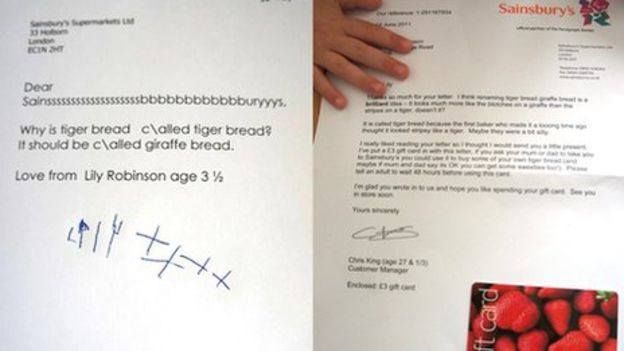
He also attached a gift card for her—signed “Chris King (age 27 & 1/3)”.
The letter went viral once Lily’s mom posted it on social media. In response, the supermarket ended up changing the name of “tiger bread” to the more appropriate “giraffe bread.”
Why it’s great:
This example is so great at surpassing expectations that you’ve probably heard the story already. And when you’re back at Sainsbury’s, you’ll probably check to see if it’s still called “giraffe bread” and tell the story to whomever you’re with.
Surpassing expectations makes for great stories. If you do it well, a good customer experience can be worth more than an expensive marketing campaign.
2. Gaylord Opryland Hotel – Generous Customer Service
For three years in a row, Christina McMenemy stayed at Gaylord Opryland Hotel for the annual BlissDom conference. Each time she did, she really enjoyed one feature of her room: the alarm clock that played soft music.
She looked for that clock for three years, in order to purchase it herself. But she couldn’t find it. So she decided to tweet to Gaylord Opryland Hotel and ask about it:



Bottom line: It wasn’t available. Christina went to her conference knowing that she couldn’t get the clock. However, when she returned to her room, she found a little gift waiting for her…

The hotel had listened to her and rewarded her customer loyalty with her own clock.
Why it’s great:
Gifts don’t necessarily have to be expensive or extravagant. They just have to be what your customer needs. The hotel probably had a surplus of these clocks, in order to replace them when they broke.
By giving one to this customer, they were able to get a lot of goodwill from people on Twitter, brand exposure, and a customer who would be loyal for life.
3. Spotify – Timely Customer Service
In 2016, Sophia Skinbjerg, a paying user of Spotify, noticed that their servers seemed to be down:

Spotify immediately responded and engaged with her. After a while, they confirmed that they’d had a temporary issue that they’d resolved. Sophia was so impressed by Spotify’s timely communication that she thanked them in a tweet. Spotify responded to her again:
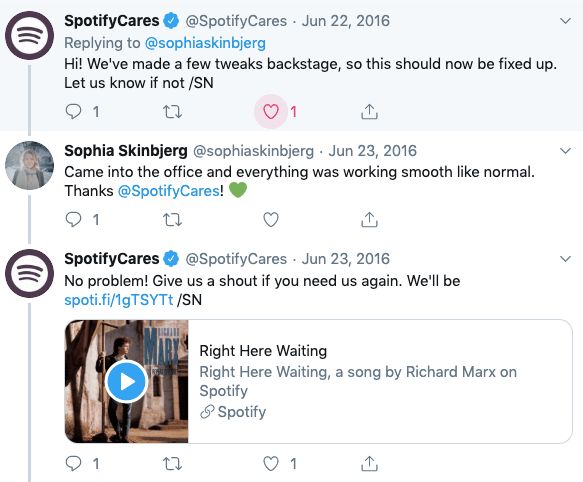
End of story, right? Well, not really. Spotify wasn’t done with Sophia’s interaction. They quickly replied with a custom playlist they’d made just for her. How? Well, just read the titles:

And you probably guessed Sophia’s reaction:
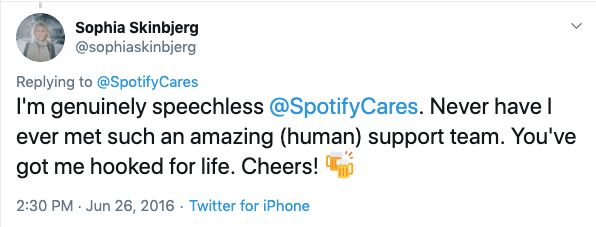
Why it’s great:
Spotify was able to get Sophia “hooked for life” because they started their amazing interaction with her off on the right foot: They replied early.
If you’re quick to reply to your customers when there’s an issue, you can transform that negative experience into the best experience they’ve had so far.
4. Tommee Tippee – Empathetic
In 2016, a desperate father asked Twitter for one thing: a blue plastic cup:
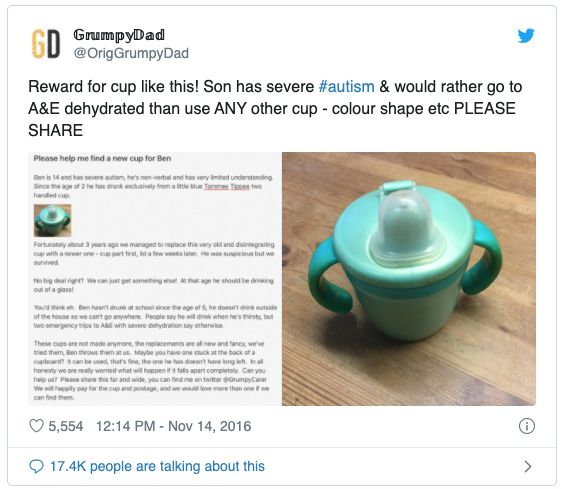
He couldn’t find any cups because the manufacturer, Tomme Tippee, had discontinued it years earlier.
The tweet quickly went viral with people all over the country, who started looking in their cupboards for a cup just like that. And to help people find the cup, Tommee Tippee created a website that would amplify the dad’s voice and connect him with the right cup:
Finally, after receiving many cups, the company was able to locate the molds and gifted Ben 500 brand-new sippy cups.
Why it’s great:
Tommee Tippee paid attention to their media channels, in order to connect with the client who needed them the most. Instead of simply retweeting, they realized the father was in great anguish, and they went above and beyond to solve his issue, which garnered massive media attention and good faith.
Place yourself in your client’s shoes, and truly listen to them when they need you. Empathy is the best way to find out what your client needs and deliver on it.
5. Morton’s Steakhouse – Solution-Driven Customer Service
When Peter Shankman was about to board a plane, he realized he hadn’t eaten. So he would be starving when he landed. He got inspired by the situation and sent a funny, clever tweet to Morton’s Steakhouse:
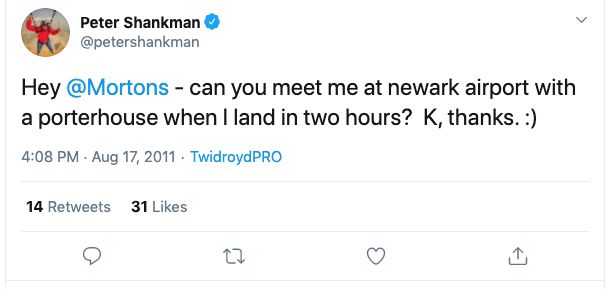
Morton’s response? A great landing surprise for Peter:
What a lot of people miss from this story is that Peter wasn’t any user. As you can see by his verification Twitter profile, he’s a notable figure: an author. But not just any author. He’s a customer service consultant.
Morton’s Steakhouse used this opportunity to deliver a simple but powerful statement: We will go the extra mile to solve your issue. And they did it with the guy that literally wrote the book (or one of them) on customer service. They knew this action could only amplify their message. And that’s exactly what he did.
Why it’s great
Despite the incredible logistics, Morton’s Steakhouse was able to pull off an incredible stunt, in order to solve the customer’s issue. Learn from your customer service reps and give them room to excel at their customer service, instead of delivering script-based responses.
After all, if you want to deliver exceptional customer service, you’ll need exceptional customer service reps.
5 Exceptional Customer Service Tips You Can Implement in Your Customer Service
Want to start delivering exceptional customer service?
Here are five tips to help you get you started…
1. Track efficiency and speed.
As we already mentioned, timely and efficient resolutions are vital for exceptional customer service. So you need to measure the average time it takes your service reps to solve an issue.
To calculate efficiency, tracking your team’s speed won’t be enough. Instead, you’ll need to find out how many times you get queries from the same customer. Ideally, customers should only contact you once. If they contact you more than once, find out why they contacted you. Repeated calls from the same customer with the same issue are red flags of potential issues with your customer service or your company.
If you want to find ways to improve, it’s vital for you to get the right insight. That’s why we developed Messagely.
With Messagely’s knowledge-based software, you can both increase your response time and allow your clients to solve their questions on the spot. By linking the customer’s issues to relevant blog articles and content, the customer can immediately solve their issues —without having to call your team!
But what if they can’t find what they’re looking for?
Messagely gives you access to failed search data (what people searched for, but didn’t find). So you can find gaps in your current communication and improve their experience.
Sign up for a free trial.
2. Prepare ways to offer additional and unexpected value.
Your company can’t be good at everything, but it doesn’t have to be. It’s better to be amazing at one thing than to be mediocre at everything. So you need to pinpoint your company’s strengths and capitalize on them.
Therefore, look into the reasons why your customers buy from you. What does your company have to offer? How are you better than your competition? Why should people choose you over everyone else?
Once you’ve identified your strengths, find ways to over-deliver on them. For Disneyworld, it’s all about the guests. That’s why employees are encouraged to give small freebies to guests, such as pins, bags, fast passes, and even tees!
Get started
Find out what makes you great, and give your reps the tools to be generous with your customers. These tools may involve giving your reps as much time as they need to spend with the customer, the power to remove fees from the client’s bill, and small freebies they can give your clients.
Foster an environment where your reps are inspired to give great service and be rewarded for being generous to your clients.
3. Empathize first.
People like to feel heard and understood. You don’t have to agree with them, but you have to understand them. However, this action can be incredibly hard for your employees, especially when they hear the same issues every day.
Get started:
Encourage your reps to establish a rapport with your customers. It’s not enough to say, “Yes, that’s frustrating,” or, “I know the feeling.” Instead, place them in your customers’ shoes.
Start by identifying the customer’s problem. If that problem is, say, that their modem doesn’t work, encourage your reps to use it in their reply with something like, “I would also be frustrated if I didn’t have WiFi at home.”
Even small things about what they say and how they say it can quickly let your clients know that they’re talking to someone that understands them—not just with a customer rep of a faceless company.
From the get-go, hire the right customer service reps, based on their people skills and listening skills.
BONUS: By using wording that involves your customer’s issues, your reps will also get to confirm the customer’s issue. By properly identifying their problem, they can fully focus on the solution!
4. Asking customers for their feedback
According to Hubspot, 42% of companies don’t collect customer feedback. If a company doesn’t listen to their customers, they won’t understand their expectations.
Collecting customer feedback is vital to being able to understand and empathize with your customer. If you understand what your customer needs, you can easily deliver on it. And if you’re delivering on what your customers need, why would they look for anyone else?
Acquiring feedback is a crucial way to empathize with your customers.
You may have noticed this trend: After you have a particularly bad experience on Facebook Messenger or Whatsapp, they usually ask you to rate the call and add the reason why you rated it like that. This protocol serves two purposes:
- You get to rate them poorly. Then you don’t feel the need to criticize them again on the platform itself.
- They get to know exactly what the problem was.
Get feedback—not only about what you’re doing right, but also about what you’re doing wrong.
Get started:
Use surveys to collect customer feedback, and make them easy and fun to fill out. After a bad experience, give your customers a potential reward for recollecting their feedback. By getting to know their experiences (good and bad), you will gain valuable insights into what you can exploit and what you need to work on.
5. Standardize answers.
Standardization helps your team be consistent and have the right answers to your customers’ most common questions.
If you do it well, it can dramatically improve your customer service speeds and issue resolutions.
With standardization, you also get homogenous attention, better-prepared employees, and an increased focus on problem resolution. If your employees know how to solve your customers’ problems, they’ll be more likely to solve them quickly and effectively.
Get started:
Give your reps a guideline for your customers’ common issues and train them to solve them as quickly as possible. Make sure they know what tools they have at their disposal, and confirm they’re following the company’s values.
The most important part of any training has to involve regularly solving your customer’s pain points. Make sure all of your reps can identify them and solve them as quickly as possible.
Conclusion
Remember, to provide exceptional customer service, your service has to be exceptional. So every day, you and your team need to prepare for facing new customers and making every interaction count.
The secret to getting loyal customers is treating your customer exceptionally well. Unique customer service tends to go viral. So make every interaction a good one!



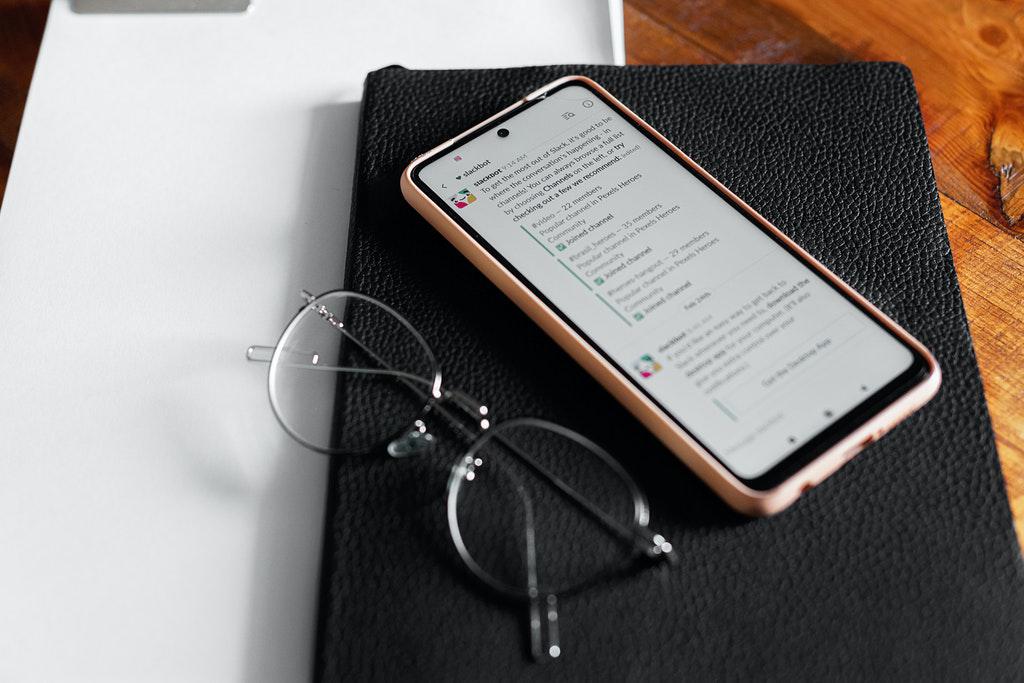



 Instagram
Instagram